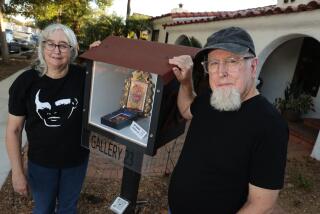Where the Art Is
- Share via
In response to “Looking for Art in All Wrong Places (Like Hospital Cafeterias)” by Cathy Curtis (Calendar, June 17), we feel the public deserves to read a differing viewpoint.
Admittedly, our exhibition space is not a traditional one where viewing visual art is its only concern, but neither are some of the other community galleries, such as the Newport Beach Library and the Beckman Institute.
Our goals as a community exhibition space are twofold. Initially, we research and gather emerging and established artists’ works relating to a theme. The art is carefully placed, labeled and sensitively lit. Secondly, we provide an accessible public viewing space for art where educational information is available. Artists’ statements are conveniently displayed in a supportive manner.
So what if displaying art is not the primary function of the space? Realistically, many adults and children do not consciously seek contemporary art. Their exposure to current visual art may be limited to non-traditional exhibition spaces such as ours.
In an idealistic model, art is viewed as a “discreet entity” in its own environment. In the ‘90s, however, this elitist viewpoint is impractical for reaching and educating a large audience.
As directors of the IMC Gallery, we have docent tours for elementary students, senior citizens, Scout troops and community service activists. At a time when art education is being eliminated or threatened in the public school system, our gallery space provides a much needed community service.
In the “Metalworkings” exhibit, five of the eight artists participated actively in the placement and lighting of their work, assisted by a preparer and two curators. We admit that placing stanchions before two of Brian Bosch’s works may limit their “spatial authority.” However, the artist, understanding this safety measure, preferred to have his works seen. And isn’t that really the point?
Should art only be exhibited in the limited number of galleries and museums designed for that sole purpose? Historically, art has been exhibited in armories, garages, lofts, salons, libraries, banks and coffeehouses. Inspired by the Zen Koan, we submit: Can art exist if no one sees it?
The only “wrong place” was your placement of the photograph of Gary Martin’s “Fedora,” which appeared sideways in the newspaper.
BRENDA GLOBERSON
Irvine
Globerson is a director of the IMC Gallery.
More to Read
The biggest entertainment stories
Get our big stories about Hollywood, film, television, music, arts, culture and more right in your inbox as soon as they publish.
You may occasionally receive promotional content from the Los Angeles Times.










